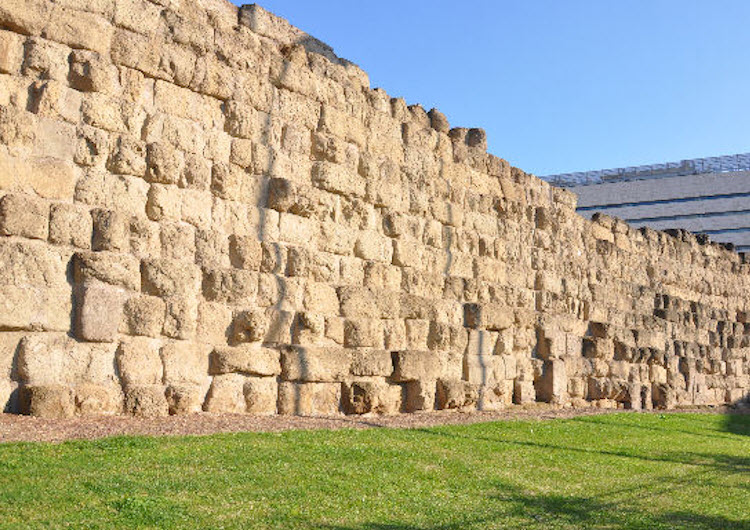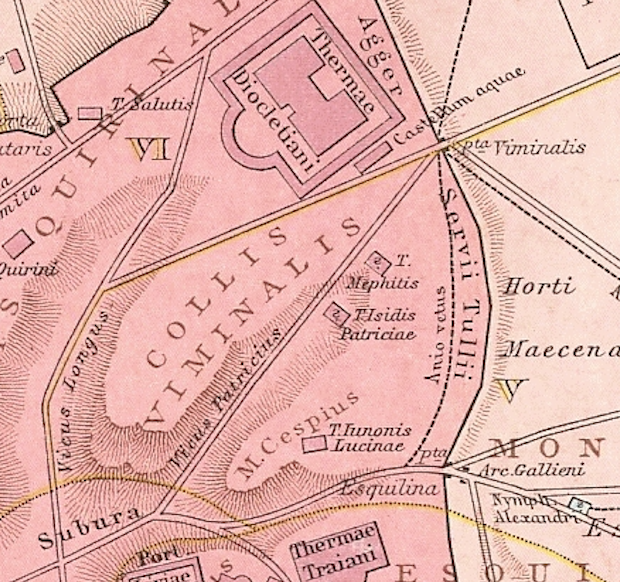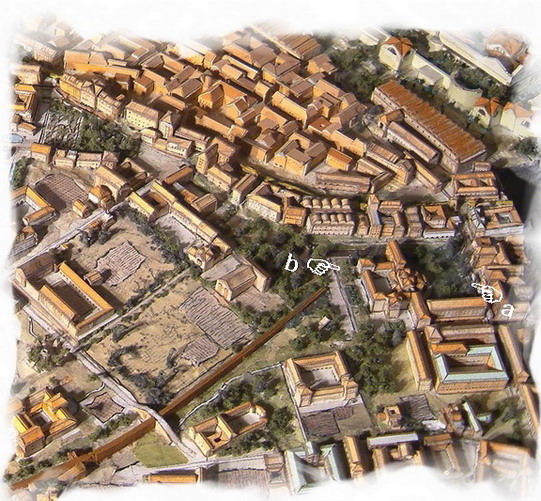In this journey, you will read about how Jupiter rescued Perseus and his mother, Danaē, from the sea and how they came to the island of Seriphus, where they met a kindly fisherman and a king. Along the way, we’ll review Third Declension Nouns and Third Declension Adjectives.
A. Let’s start by reading the next chapter of our exciting fābula dē Perseō: Iuppiter Perseum servat (Jupiter saves Perseus).
Iuppiter tamen, pater deōrum, omnia crūdēlia videt, et fīlium suum servāre cōnstituit. Tranquillum igitur facit mare, et arcam ad īnsulam Serīphum māgnā cum celeritāte perdūcit. Polydectēs tum rēx erat īnsulae Serīphī. Postquam mare tranquillum arcam ligneam cum fīliō Iovis ad lītus movet, Danaē in harēnā pācem capit.
Post breve tempus piscator mātrem et infantem invenit, et duōs ad domum rēgis Polydectis dūcit. Polydectēs mātrem et infantem benignē excipit, et iīs domum tūtam in fīnibus suīs dat. Danaē dōnum rēgis Polydectis accipit hilaris, et prō tantō beneficiō rēgī grātiās agit.
B. Always read and re-read until you have a good sense of the story.
Check your understanding by completing this brief comprehension quiz in Cerego. If you any of the answers eluded you, be sure to return and re-read the story and try again!
C. Now, let’s continue our tour of basic Latin morphology. Invest 5 minutes reviewing basic or consonant-stem Third Declension Nouns.
You can learn more about Third Declension Nouns in Allen & Greenough §53 (stem endings), 54 (classifications), 55 (nominative), 56 (mute stems), 57 (declination of mute stems), 58-59 (gender of mute stems), 60 (irregularities), 61 (liquid and nasal stems), 62 (liquid and nasal stems declined), 63-64 (liquid and nasal stem neuters), 65 (i-stems), 66 (pure i-stems defined), 67 (pure i-stems declined), 68 (i-stem neuters), 69 (more declensions), 70 (mixed i-stems defined), 71-72 (mixed i-stems declined), 73-78 (i-stems summary), 79 (irregular third declension nouns), 80 (locative case), 81-83 (Greek nouns of the third declension), 84-87 (gender),
D. Feeling confident about the basic contours of consonant-stem Third Declension Nouns?
Complete this short comprehension exercise, which will verify that you know the basic in’s and out’s of Third Declension Nouns.
E. Let’s practice consonant-stem masculine and feminine Third Declension Nouns.
1. Complete the Third Declesion Paradigm of pater on Magistrula.com (the activity is cued up at the link, just click BEGIN; you can also access it from “My Stuff” once you have created an account on the site).
For additional practice, you can also compete paradigms of nepōs, infāns, māter, tempestās, rēx, pāx, and/or fīnis. Or you can practice with a random Third Declension noun (masculine and feminine only for now, and no i-stems yet, either!).
✮ Practice these paradigms on Magistrula.com, write them out again and again on a sheet of paper, muttering to yourself as you exercise, or in any way that works for you until you are completely and totally confident in your ability to reproduce the paradigm of any basic masculine or feminine third declension noun.
2. Practice Identifying Third Declension Forms on Magistrula.com until you feel very confident that you can identify the case and number of any basic masculine or feminine Third Declension Noun that comes your way.
If you need additional practice with the forms, invest a little more time with the Quizlet sets on (a) the basic endings of Third Declension nouns, (b) the forms of pater and/or (c) the forms of pater, mater, and rēx in the story. The, return to Magistrula.com to practice some more.
F. You’ve reviewed masculine and feminine Third Declension Nouns, but that’s only a third of the story. Let’s look first at Third Declension Neuter Nouns.
1. Invest 4 minutes to review Third Declension Neuters by watching this video.
2. Complete the Third Declesion Neuter Paradigm of tempus on Magistrula.com (the activity is cued up at the link, just click BEGIN; you can also access it from “My Stuff” once you have created an account on the site).
3. Practice Identifying Third Declension Noun Forms on Magistrula.com until you feel very confident that you can identify the case and number of any Third Declension Neuter Noun that comes your way.
4. Reinforce your knowledge of Third Declension Nouns by declining noun-adjective phrases that contain a Third Declension Noun and a First-Second Declension Adjective.
G. Now let’s re-read the first two chapters of our fābula, with special attention to the Third Declension Nouns therein.
Notā bene: some of the words from Chapter 1 have been replaced with more elegant and apposite Third Declension Nouns.
Multī fābulās dē Perseō nārrant. Perseus fīlius erat Iovis, maximī deōrum, et quoque fīlius Danaēs. Danaē est fīlia Ācrisiī. Ergo avus Perseī est Ācrisius. Sed Ācrisius vult Perseum nepōtem suum necāre; nam propter ōrāculum puerum timet. Comprehendit igitur Perseum adhūc īnfantem, et cum mātre in arcā ligneā ponit. Tum arcam ligneam in mare mittit. Danaē, Perseī māter, magnopere timet; tempestās enim magna mare turbat. Perseus autem in gremiō mātris dormit.
Iuppiter tamen, pater deōrum, omnia crūdēlia videt, et fīlium suum servāre cōnstituit. Tranquillum igitur facit mare, et arcam ad īnsulam Serīphum māgnā cum celeritāte perdūcit. Polydectēs tum rēx erat īnsulae Serīphī. Postquam mare tranquillum arcam ligneam cum fīliō Iovis ad lītus movet, Danaē in harēnā pācem capit.
Post breve tempus piscator mātrem et infantem invenit, et duōs ad domum rēgis Polydectis dūcit. Polydectēs mātrem et infantem benignē excipit, et iīs domum tūtam in fīnibus suīs dat. Danaē dōnum rēgis Polydectis accipit hilaris, et prō tantō beneficiō rēgī grātiās agit.
H. There’s another flavor of Third Declension nouns that is very similar to consonant stem Third Declension but have an ‘i’ in a few of their cases. Invest 5 minutes to review Third Declension I-Stems.
Caveat disicula/us! The closer one looks at the third-declension words, the more minor irregularities one finds. Even the Romans themselves found the third declension to be the messiest of the declensions. The good news is that these variations, which are related to i-stems, are relatively minor and affect only a few cases in some words. You can probably get by without mastering them, but if you’d like to learn more, you can invest 5 minutes in watching this video on “Mixed I-Stem Third Declensions.”
I. Now practice Third Declension Nouns in all their forms.
1. Practice Identifying all Third Declension Noun Forms on Magistrula.com until you feel very confident that you can identify the case and number of any Third Declension Noun that comes your way.
2. Practice Recognizing Third Declension Nouns in context, as they appear in the story, using this Cerego activity.
J. Nicely done! You’ve earned a rest in the shade of the formidable Servian Walls, which protect Rome’s 7 Hills.

These walls were built soon after the Gallic Sack of Rome in 390 BCE. It was these towering, 30-foot walls that deterred Hannibal from attack Rome during the Second Punic War.
K. Now let’s put your knowledge of Third Declension Nouns, and especially I-Stems, to work by mastering Third Declension Adjectives. Begin by investing 7 minutes reviewing the second and last flavor of the Latin adjective.
You can learn more about Third Declension Adjectives in Allen & Greenough §114 (consonant and i-stems), 115 (adjectives of 3 terminations), 116 (adjectives of 2 terminations), 117, 118, and 119 (adjectives of 1 termination),
L. Are you ready to tackle Third Declension Adjectives?
Complete this short comprehension exercise, which will verify that you know the basics about Third Declension Adjectives, include the various ways they can appear in dictionary entries.
M. Let’s practice Third Declension Adjectives
1. Complete the Third Adjective Paradigm of omnis on Magistrula.com (the activity is cued up at the link, just click BEGIN; you can also access it from “My Stuff” once you have created an account on the site).
For additional practice, you can also compete paradigms of brevis and/or crudelis. Or you can practice with a random Third Declension Adjective.
✮ Practice these paradigms on Magistrula.com, write them out again and again on a sheet of paper, muttering to yourself as you exercise, or in any way that works for you until you are completely and totally confident in your ability to reproduce the paradigm of any third declension adjective.
2. Practice Identifying Third Declension Adjective forms on Magistrula.com until you feel very confident that you can identify the case and number of any Third Declension Adjectives that comes your way.
If you need additional practice with the forms, invest some time with the Quizlet set on (a) the forms of brevis and/or (b) the forms of the Third Declension Adjectives in our fābula. Then return to Magistrula.com to practice some more.
3. But wait! Since the superpower of adjectives is modifying a noun by agreeing with it in case, number, and gender, you should practice making Third Declension Adjectives agree with a noun by (1) declining at least one Third Declension noun-adjective phrase; (2) declining at least one phrase with a Third Declension Adjective and a First or Second Declension Noun; (3) and identifying noun-adjective phrases (Third Declension noun-adjective phrases; Mixed Declension noun-adjective).
N. Now let’s re-read Chapter 2, with special attention to Third Declension Adjectives.
Iuppiter tamen, pater deōrum, omnia crūdēlia videt, et fīlium suum servāre cōnstituit. Tranquillum igitur facit mare, et arcam ad īnsulam Serīphum māgnā cum celeritāte perdūcit. Polydectēs tum rēx erat īnsulae Serīphī. Postquam mare tranquillum arcam ligneam cum fīliō Iovis ad lītus movet, Danaē in harēnā pācem capit.
Post breve tempus piscator mātrem et infantem invenit, et duōs ad domum rēgis Polydectis dūcit. Polydectēs mātrem et infantem benignē excipit, et iīs domum tūtam in fīnibus suīs dat. Danaē dōnum rēgis Polydectis accipit hilaris, et prō tantō beneficiō rēgī grātiās agit.
O. Practice Recognizing Third Declension Adjectives in Context
In this Cerego activity, you will identify only the case, number and gender of the Third Declension Adjectives as they appears in the story.
P. Would you like some more practice reading simple Latin sentences built with Third Declension Nouns and Adjectives?
If yes, then have I got just the exercise for you!
Want more? Here’s an exercise with First, Second, and Third Declension Nouns and Adjectives.
If you are ready, then continue to your destination.
Q. Re-read the first two chapters of our fābula with special attention to Third Declension Nouns and Adjectives.
Multī fābulās dē Perseō nārrant. Perseus fīlius erat Iovis, maximī deōrum, et quoque fīlius Danaēs. Danaē est fīlia Ācrisiī. Ergo avus Perseī est Ācrisius. Sed Ācrisius vult Perseum nepōtem suum necāre; nam propter ōrāculum puerum timet. Comprehendit igitur Perseum adhūc īnfantem, et cum mātre in arcā ligneā ponit. Tum arcam ligneam in mare mittit. Danaē, Perseī māter, magnopere timet; tempestās enim magna mare turbat. Perseus autem in gremiō mātris dormit.
Iuppiter tamen, pater deōrum, omnia crūdēlia videt, et fīlium suum servāre cōnstituit. Tranquillum igitur facit mare, et arcam ad īnsulam Serīphum māgnā cum celeritāte perdūcit. Polydectēs tum rēx erat īnsulae Serīphī. Postquam mare tranquillum arcam ligneam cum fīliō Iovis ad lītus movet, Danaē in harēnā pācem capit.
Post breve tempus piscator mātrem et infantem invenit, et duōs ad domum rēgis Polydectis dūcit. Polydectēs mātrem et infantem benignē excipit, et iīs domum tūtam in fīnibus suīs dat. Danaē dōnum rēgis Polydectis accipit hilaris, et prō tantō beneficiō rēgī grātiās agit.
Z. Once you have successfully completed these activities, congratulations! You have taken the next step on your (re)exploration of Latin — and Rome — by Scaling the Viminal Hill.
Other Resources and Practice on Third Declension Nouns and Adjectives
- Magistrula.com: [Paradigm of pater] [Identifying Third Declension forms] [Paradigm of tempus] [Identifying Third Declension Noun forms] [Paradigms of Noun-adjective Phrases] [Identifying all Third Declension Noun forms] [Paradigms of Third Declension Adjectives] [Identifying Third Declension Adjective forms] [Simple Sentence Practice]
- Latintutorial.com: [The Third Declension] [The Neuter Third Declension] [Third Declension i-stems] [Third Declension Adjectives]
- Quizlet.com: [Morphology of Third Declension Nouns] [Morphology of pater]
- Cerego.com: [Reading Comprehension] [Third Declension Nouns Comprehension] [Third Declension Nouns in Fābula] [Third Declension Adjectives Comprehension] [Third Declension Adjectives in Fābula]


